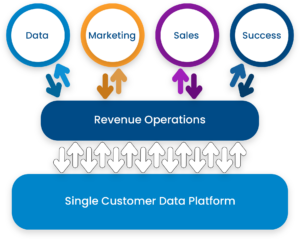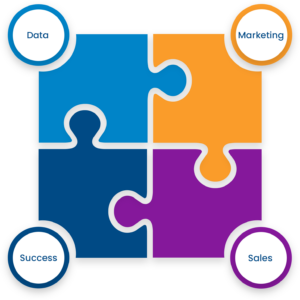Revenue Operations – What is it and what problems does it solve?

Organisations have had to adapt to a ton of changes in recent years, one of the most significant involves trying to use organisational systems developed in the 20th century to manage a far more advanced and complex digital commercial model in the 21st Century.
These challenges have led to the rise of Revenue Operations (RevOps for short), with Gartner predicting that 75% of the highest growth companies in the world will deploy a RevOps model by 2025. So, let’s take a deeper dive into RevOps.
What is Revenue Operations?
In its simplest form, Revenue Operations is the combination of data, processes, and technology aligned to drive efficiencies and scale go-to-market efforts across an organisation. The goal of RevOps is to close the gap between marketing, sales, and customer success teams so that they can work together seamlessly to attract, engage and retain customers.

Why was RevOps created?
The main reason why RevOps came about was due to businesses realising that the traditional organisational structure no longer cut it in today’s day and age.
The main issues with this old way of doing things were – information wasn’t flowing freely between departments (mainly because departments were siloed off from one another), decision making was slow because there were too many people involved, and processes were outdated and inefficient.
In order for businesses to keep up with the competition, they needed to find a way to operate as one cohesive unit instead of a bunch of disconnected parts. Enter Revenue Operations.
Here are some quick stats that sum up just how big these problems have become:
|
What problems does RevOps Solve?
“Our process isn’t working!”, “Our data and tools are a mess!”, “The team is disjointed. No one is working together.”
Sound familiar? Let’s take a closer look at each one.
1) “Our process isn’t working!” – One of the main goals of RevOps is to streamline processes so that they are more efficient and effective. This involves creating standardised processes across all departments within an organisation as well as automating manual tasks wherever possible. By streamlining processes, organisations can eliminate bottlenecks, speed up decision making, and improve collaboration between departments.
2) “Our data and tools are a mess!” – Another key goal of RevOps is to clean up an organisation’s data so that it is accurate and consistent across all departments. This can be a huge challenge for organisations because it often requires changing long-standing business practices as well as investing in new technology platforms that can handle large volumes of data. However, by cleaning up an organisation’s data, teams are able to make better decisions based on facts instead of gut feel which leads to improved operational efficiencies and increased revenues.
3) “The team is disjointed. No one is working together.” – The final goal of RevOps is to break down silos between departments so that everyone is working towards common objectives. This can be accomplished by implementing gamification techniques such as scorecards and leaderboards that encourage teamwork as well as investing in a technology platform that facilitates collaboration between team members . When silos are broken down and teams are working together towards common objectives, organisations are able operate at a much higher level which leads to increased revenues.

Conclusion: Revenue Operations was created in order to help businesses close the gap between go-to-market teams so that they can work together seamlessly to attract, engage and retain customers. The goal of RevOps is to streamline processes, clean up data, and break down silos between departments so that everyone is working towards common objectives.
If your business doesn’t have a Revenue Operations function yet, now is the time to start thinking about implementing one as it will be crucial for your organisation’s long-term success.
Want to talk to a Zymplify expert on how our go-to-market revenue platform could work for your business personally? Then sign up for a free personalised demo here.







